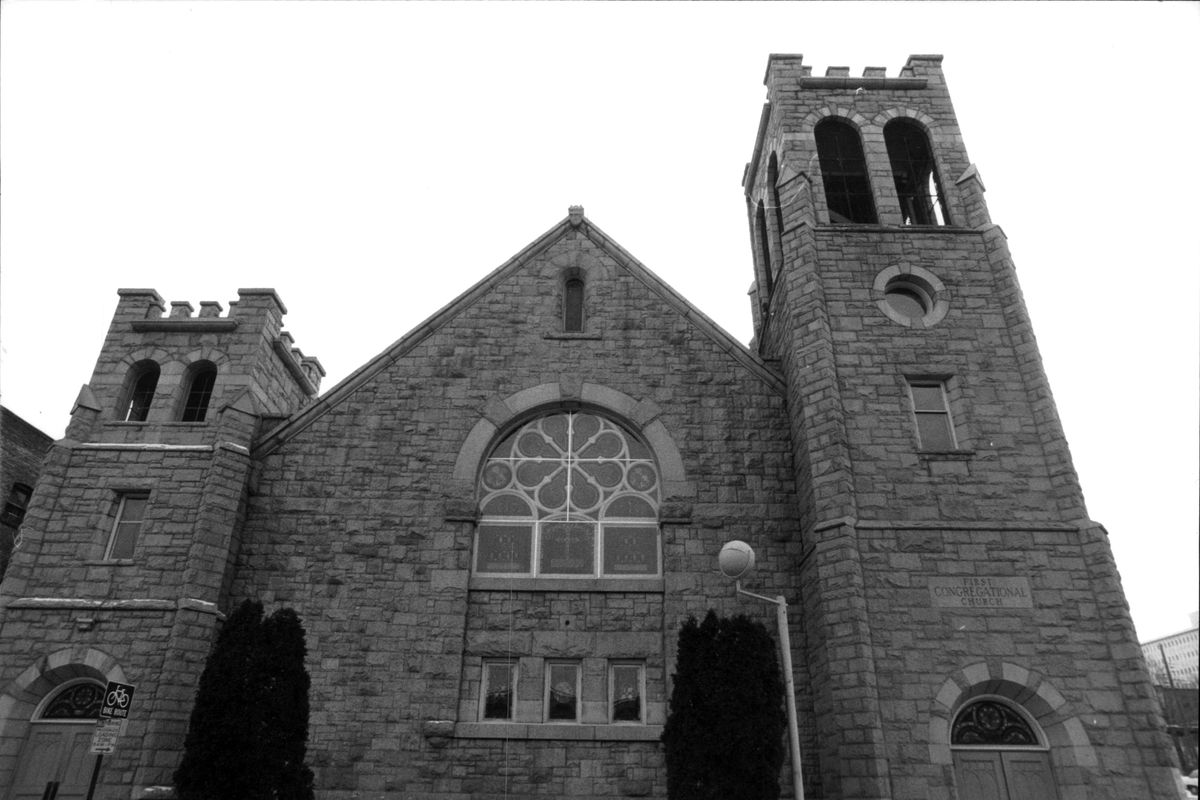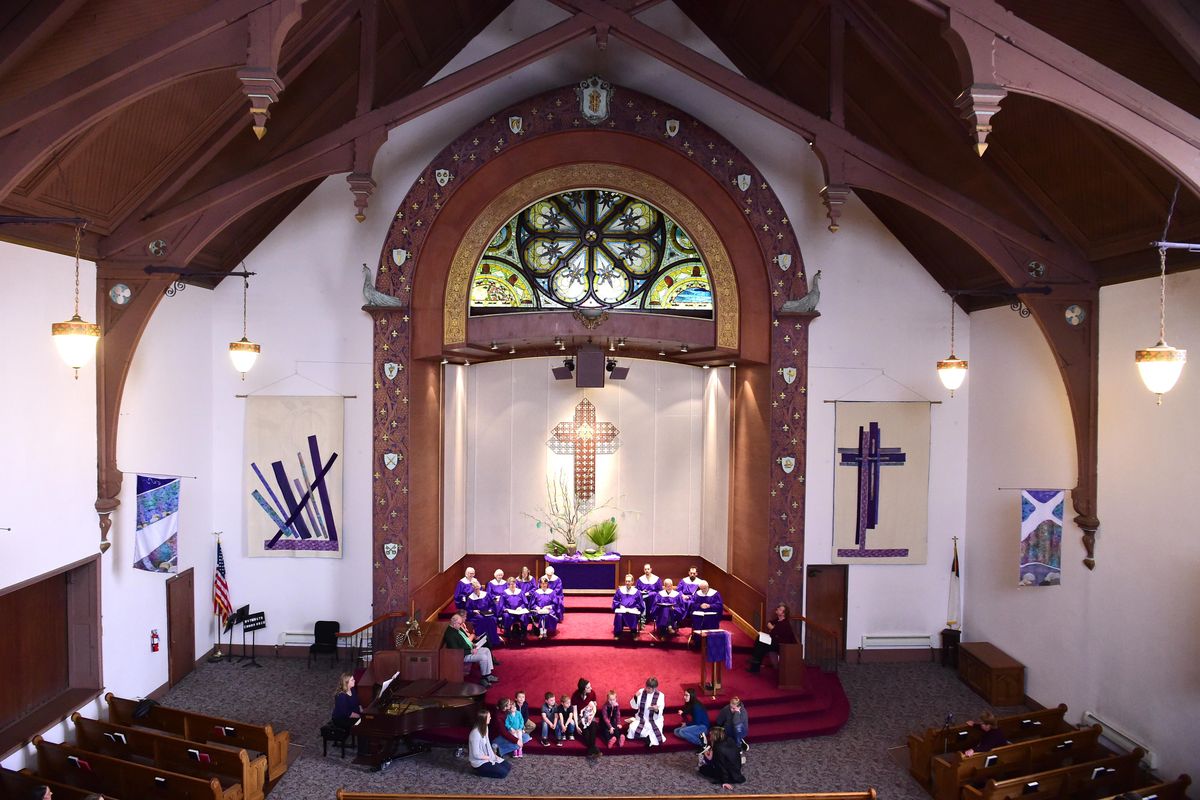Spokane’s oldest organized church, Westminster Congregational Church of Christ, prepares for 140-year celebration

The palm fronds made their processional down the aisles at Westminster Congregational United Church of Christ last Sunday, as Spokane’s oldest church prepares to celebrate its 140th birthday.
“Nobody knows if we’re going to be here at 150 years, so let’s party now,” said the Senior Pastor Andy CastroLang, who’s served at the stately downtown house of worship for the past 16-plus years.
Stained glass, the solemn but triumphant observance of Jesus’ entry into Jerusalem and a cornerstone signifying the completion of the stone sanctuary in 1927 are all trappings of a church that traces its existence to the years before Spokane could call itself a city. But the congregation within, and its philosophic underpinnings, are anything but stuck in the past.
“Andy says this every week: You are safe here,” said Jane Baker, who started attending Westminster after they declared themselves open and affirming to members of the LGBTQ community in 2007. “We think that’s really important, and it’s a really comforting thing. There is a place that I can go in this city and feel safe.”
Hanging from the balcony in the sanctuary, which was built before all of its 200-plus members were born, are flags affirming the church’s commitment to the gay and transgender communities. The banners have scared away some potential new members who walk in, expecting a more traditional church experience, CastroLang said.
But just as the church’s role in helping found the Spokane Alliance, a group promoting social justice in the community, and pushing for inclusion of all regardless of sexual orientation has served as a divisive position for some, it has welcomed others, including those seeking respite from the cold on the streets.
Baker, who grew up in the Methodist Church, found Westminster about a decade after coming out as gay. Baker didn’t feel as accepted as she did at Westminster.
“Once I came out, it wasn’t as fully fleshed out as it is at Westminster, that you can be who you are,” Baker said. “You don’t have to hide.”
Next month, Westminster will mark 140 years in Spokane, all of them in the downtown core as an extension of the faith tradition’s legacy as a community church dating back to the New England town squares. But the survival of a downtown church in those first years, and the intervening decades, was not certain.

‘A ministerial sort of scrap’ for existence
The Rev. Jonathan Edwards had had enough.
Westminster Congregational Church’s fourth pastor spent the morning of April 17, 1890, trying to convince a pair of squatters that the land where they’d erected hasty lean-tos belonged to his church, and that excavation needed to begin on building a new sanctuary at the corner of Washington Street and Fourth Avenue.
It wasn’t going well, according to an account that appeared in The Spokane Daily Chronicle.
“Rev. Jonathan Edwards had been doing all in his power to persuade the men to move off,” a reporter, who witnessed the scene, wrote for the newspaper. “But they decidedly objected to so doing, the result was a ministerial sort of scrap. Rev. Edwards took a hand in the fight and the result was a sort of double back action arrest.”
The Chronicle’s interest in the survival of the church, first located at Sprague Avenue and Bernard Street (now the corner where the Spokane Comedy Club and Spokane Intermodal Center sit) before it burned in the great fire of 1889, was more than just academic. Its publisher, Henry T. Cowley, had founded the church 11 years before in the living room of his 16-foot by 24-foot log cabin built near the present site of Division Street and Sixth Avenue, and served as the church’s first acting pastor.
Early church records were lost in the fire, but Cowley’s daughter, Edith, was one of several children baptized into the Protestant faith at that first meeting of the Congregational church on May 22, 1879, according to minutes that survived. Edith Cowley Stillman, as she was known then, provided few details of that first service in a remembrance published on Westminster’s 50th anniversary in 1929.
“It must have been a simple service,” Stillman, who would have been about 12 at the time, recalled. “It seems to me there were about 12 charter members. It was the solemn occasion of my joining the church, but what we did I do not recall.”
Cowley served as pastor of the church for a couple of years, then began operations of the newspaper, the Spokane Falls Chronicle, in 1883.
Among those charter members was Chief Enoch Selquawia of the Spokane Tribe of Indians. Historical accounts indicate the land that Edwards fought to defend that morning belonged to the chief and had been sold to Cowley.
The dispute between Edwards and the squatters was sparked by questions raised about who truly owned the land as railroads moved into town.
Edwards, who had preached years before in the church about “such social questions as the concentration of capital, growth of corporations, conflict of capital and labor, the rights of man, organization of labor and the like,” according to an autobiography the pastor later wrote that showed the progressive values of the church, stood his ground when he later appeared before a judge.
Westminster was erected on the site, and remodeled in 1927. Two square stone towers replaced a round turret. The church continued to blossom in the pre- and post-World War II years, eventually growing to 2,000 members.
But a conflict inside the faith would split that membership just after the church’s 75th birthday.
Membership swells before conflict rears its head
Westminster’s story is one of combining congregations. But it was some members’ desire to leave in 1964 that thrust what had become a community institution into a national conversation about the future of Congregational churches.
The congregational church has its underpinnings in the Puritan tradition of early colonial America. Even as the congregation celebrated Palm Sunday this past week, it paused at the end of the service to elect what’s known as a moderator, or a member of the church who will assist the pastor in teaching the spiritual lesson.
“The original Congregational churches were always in the center of town,” church member Baker said. “They were always for more than just worship. They were a public meeting hall.”
Robert’s Rules of Order became more important than ever in January 1964, when hundreds of churchgoers crammed the sanctuary to vote on whether Westminster would remain allied with the United Church of Christ.
Westminster’s own name reflected its history of combining with other congregations. Westminster had been a Presbyterian church in town when it combined with Cowley’s congregational church in December 1893. Cowley had studied at the Presbyterian Synod-established Auburn Theological Seminary in New York before traveling west.
In the intervening years, other churches had joined the congregational church at Westminster, including the Pilgrim and Corbin Park churches in 1924.
But the vote on that January night 40 years later focused on whether a more recent merger would last. In 1961, Westminster’s congregation had approved the constitution of the United Church of Christ, which had combined members of the Reformed, Evangelical and Lutheran faiths just a few years before. The vote on whether to remain with this new church was razor thin in Spokane, being decided by 22 votes, according to newspaper accounts.
It split the congregation at Westminster, and its effects are still talked about and part of the church’s history, CastroLang said.
“Five hundred people left in one Sunday,” she said. “It literally divided the youth group.”
Those who voted to leave split off, many of them coming together to join what is today the Plymouth Congregational Church. At the time, members said they wanted to remain an independent Congregational body and worried about the influence of the United Church of Christ. Three years later, the Plymouth church purchased a synagogue from Temple Beth Shalom that is its current place of worship, at Eighth Avenue and Walnut Street.
Westminster continued its march toward social justice and embracing what many would say is a progressive view of Christianity, but which churchgoers there call a close relationship with Jesus’ teachings of love and acceptance of all.

Westminster today
In the lobby of the church, which opens out onto Fourth Avenue and the bustling traffic of Interstate 90 above, volunteers hand out the palm fronds for the service. On a table, next to the printed bulletins with church announcements and numbers to thumb to in the hymnal, sits a wicker basket full of pronoun identifier buttons that are available to all members.
It’s this juxtaposition of trappings of the old church with the embrace of modern ideas about inclusion that is the reason many current members of the church say brought them to Westminster.
“I’m from North Idaho, Coeur d’Alene specifically, and I so wish there was a church like this there,” said Shane Bell, a 29-year-old who began attending the church after learning about them during the Women’s Day March a few years back. “A church that’s not going to judge someone by their identity.”
Bell attends Westminster with his fiancee, Bekah Smith. They attended several churches that they felt didn’t reflect Christian love to all people.
“It’s come as you are here,” said Smith, who’s provided some of the recycled material artwork for church celebrations since joining. “I feel like a lot of churches claim that, but this church really embraces people as they are.”
CastroLang said if the church were to leave downtown, as the congregation considered a few years back to find a new, easier-to-maintain building in the suburbs, she feared the city would lose Westminster’s message of inclusion for all people.
“If we disappeared, there would be a real theological hole in the city,” CastroLang said. “There aren’t a lot of downtown churches left.”
The stone building can be imposing but can also spark wonder, said Sara Weaver, a member of the church since the mid-1970s. She said before the Palm Sunday service that she didn’t agree with all the choices Westminster has made, but it has felt like home to her for years. She used to walk to Sunday services from her apartment in the historic Knickerbocker building just three blocks away, and now commutes from her home in Browne’s Addition.
“I like coming down the road and seeing it, the imposing building,” Weaver said. “We made the choice to tough it out.”
Baker said her thoughts about preserving the building as a place of worship had been amplified by the recent catastrophic fire at the Notre Dame Cathedral in Paris.
“Even though you maybe don’t need it to worship, it’s important for it to still be a vibrant part of the community,” Baker said.
The church continues its long tradition of housing social services within its walls, opening up as a warming shelter for young women this winter and continuing to host meetings for drug and alcohol recovery, as well as an after-school Lego construction team for young adults.
Before the members filed out of the sanctuary following the Palm Sunday service, they sang what CastroLang identified as an English children’s song that is sung at the end of every worship session, an affirmation of support for all members.
“May we treasure one another, may we realize how precious we are,” the group of roughly 50 congregants sings. “May we realize how precious we are. May we realize how precious we are.”